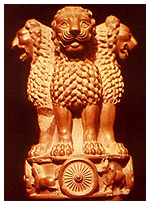
The National Emblem of India has its origin deep-rooted in rich cultural history. The National Emblem of modern India is a close replica of Sarnath Lion capital, which was erected by Emperor Ashoka circa 250 B.C.
The original Lion Capital of Emperor Ashoka, has four Asiatic Lion standing back to back on a circular abacus. It symbolizes power, pride, courage and confidence. The circular abacus is mounted on a frieze in which there are high reliefs of an elephant, a galloping horse, a bull and a lion separated by intervening wheels over a bell-shaped lotus. The wheels from the sculpture is known as “Ashoke Chakra” or “Dharma Chakra” the eternal wheel of law. The whole structure of the lion capital was carved out of a single block of polished sandstone. Emperor Ashoka erected the capital to mark the place where Gautam Buddha gave the first lesson of Dharma.

The Indian National Emblem which is a close replica of Sarnath Lion Capital features three lions. The fourth lion is being hidden. In the relief, the wheel or the “Dharma Chakra” is placed in the center of the abacus. At the right hand side of the wheel, there is a bull and a running horse is there at the left hand side of the wheel. There is a lion next to the wheel or the Ashoke Chakra. There are outlines of the Dharma Chakra on the extreme right and left hand sides of the Ashoka Chakra.
The three lions and one hidden lion represent power, pride, courage and confidence. The four animals which are on the frieze below the abacus represent the guardian of the four directions.
the lion of the north,
the elephant of the east,
the horse of the south and
the bull of the west.
The motto ‘Satyameva Jayate’ meaning “The Truth Alone Triumphs” is inscribed below the emblem. It is a quote from the Mundaka Upanishad, the concluding part of the sacred Hindu Vedas.
The Lion pillar was adopted as the National Emblem of India on 26th January 1950, the day India became a republican Nation. The National Emblem is used only for official purposes and commands the highest respect and loyalty. It is the official seal of the President of India and Central and State Governments. It is also a part of the official letterhead of the Government of India. It is also a part of all Indian currency as well as on the diplomatic and national Passport of the Republic of India. It stands as a glowing symbol identity and sovereignty of the independent India.
Try out the other sections